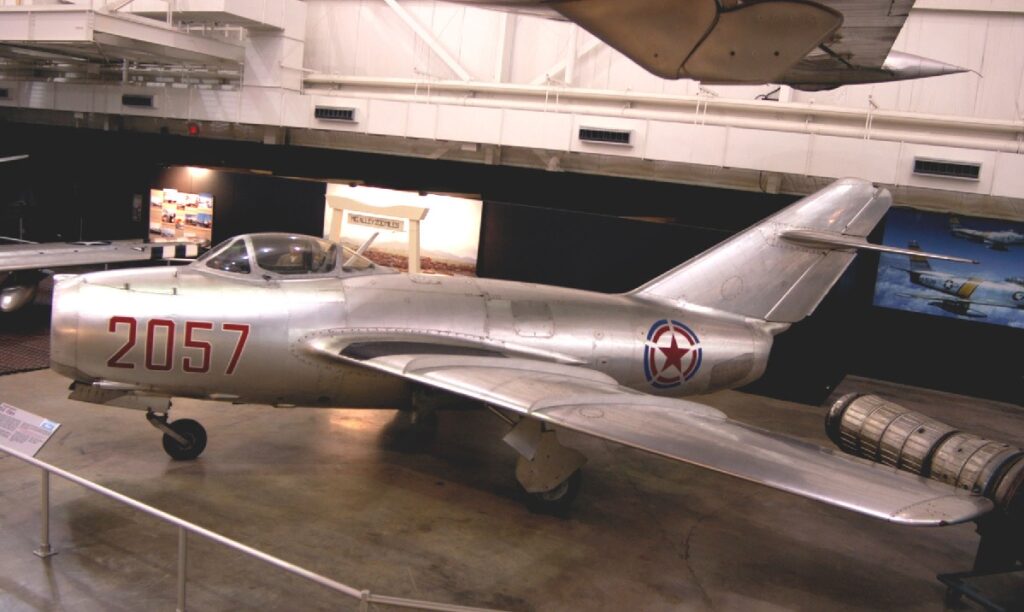F-86 pilots routinely returned from missions with their gun camera film showing kills made over Manchuria, but they were denied credit for them.
The first conflict in which jets fought for control of the skies was the Korean War. The two best fighters committed to war, the Soviet-built MiG-15 and the USAF’s F-86 Sabre, engaged in combat over the Yalu River from late 1950 until a ceasefire in July 1953. Only 140 Sabres from the 51st and 4th Wings battled the communists as they rushed more than 500 MiG-15s into bases in Manchuria to take aerial supremacy over North Korea from the United Nations Forces dominated by the USAF.
According to Warren Thompson’s narrative in his book F-86 Sabre Aces of the 51st Fighter Wing, US pilots were subject to strict guidelines on flying north of the Yalu River on paper, and numerous squadron commanders had no tolerance of any infractions. But more MiGs than anyone will ever know went down in their “safe zone.” Scores of communist jets limped back to base with heavy damage after the F-86 pilots broke off the pursuit at the river and were never able to make it back. Some MiG pilots punched out north of their bases out of sight of any gun camera film, while more were killed trying to land their downed jets.
Pilots operating F-86s frequently brought back footage from their gun cameras during flights that demonstrated kills over Manchuria, but they were not given credit for the kills since the penalty for flying over Chinese territory was much more severe than being grounded. 1 Lt Ronald Wilson, who flew F-86Fs with the 39th FS, provides a nice example of an aggressive Sabre pilot losing a kill because to the river boundary;
`We experienced mixed emotions on the day that we encountered our MiGs. It was crystal clear, and there would be nonweather problems to contend with, but conversely, we were throwing heavy, persistent, contrails out behind us that made us feel like we were in dear view of anyone in the immediate area. This was my 32nd combat mission, and I was still flying the worst wing position of them all — No 4, or “tail-end Charlie”. If the flight was attacked, it was usually the No 4 that got fired on first.
`We were flying the standard “fingertip” information. The rules for these missions had not changed since the war started. If the flight was separated, each element would stay together and fight. If the element broke up, we were required to terminate any combat and return to base.
`Since we were in the 39th FS, which was known as “The Flying Cobras”, our call signs featured snake names. On this particular day, we were “Cobra” flight. This mission took place in the early morning and our plan was to arrive at the Yalu at the highest altitude possible (45,000 ft), while trying to conserve as much fuel as we could. When we arrived, the sky was full of contrails, so there was going to be a lot of action. We could not tell who had made them, or how long they had been there.

`We were not the only Sabres up that day, and within minutes the radios were crackling with pilots calling in bandits and taking bounces on the enemy. You could hear the strain in their voices, especially when they were pulling Gs. Everyone’s head was on a swivel. The next thing I heard was “Cobra Flight, Drop tanks!” We all punched off our external, which were already empty, and a second later I heard “CobranFlight, Break Left” and the fight was on.
`As I was No 4 on the left of the flight, the turn was in to me, which was difficult for me to perform. However, I managed to maintain contact with my element leader, but when we rolled out there were no other aircraft in sight. Having lost some altitude, we proceeded to climb back up as quickly as possible. About halfway through the climb, I spotted four MiGs above us and called out to my leader. He was up at about their level, and turned to take a bounce on the last one in the formation. As soon as he fired, the MiGs scattered in all directions. I stayed in my wing position to keep my leader clear from behind. I saw him scoring hits on the trailing aircraft that had turned north for a high-speed run for the safety of the river.
`Lead radioed me that he had fired out and that I should take over the pursuit, which I did. We were less than 2000 ft behind, and were closing slightly, but the MiG was climbing, snaking it difficult for us to stay with him. I proceeded to fire and made numerous hits on him, causing the MiG to smoke and lose altitude. By this time, he was north of the river, and maybe we were too. I saw him continue to dive and smoke, and he eventually crashed into the ground, but my leader did not see it, so it was declared a “probable”. By this time I had also fired out, and we were both low on fuel, so we headed home. Had this engagement started further to the south, the MiG would have gone down over North Korea and my leader would have seen it. I could have then claimed a kill.’

F-86 Sabre Aces of the 51st Fighter Wing is published by Osprey Publishing and is available to order here.
Top image from ‘F-86 Sabre vs MiG-15’ by Doug Dildy and Warren Thompson © Osprey Publishing
Photo by U.S. Air Force

